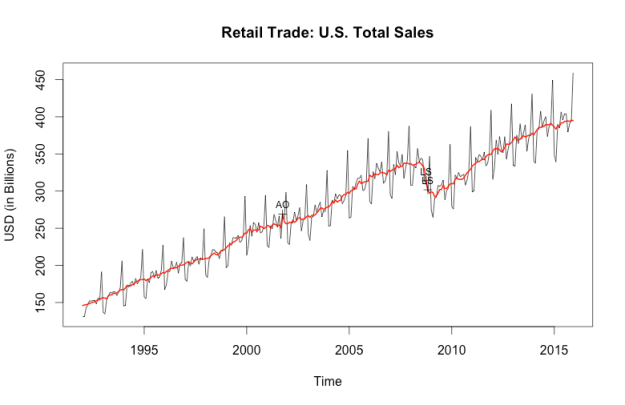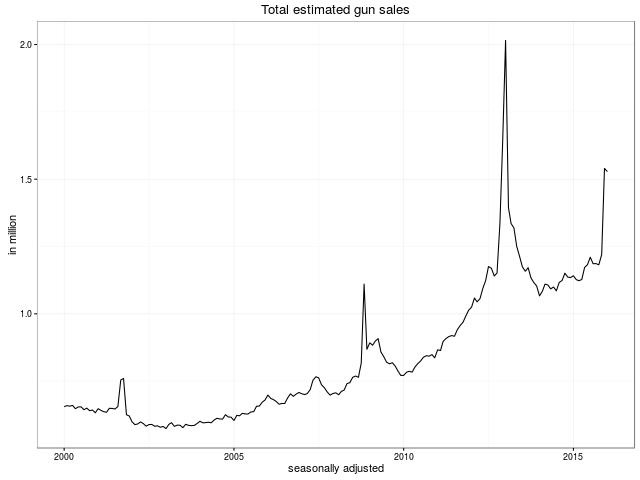Calling seasonal adjustment software from R
X-13ARIMA-SEATS, successor to X-12-ARIMA and X-11, is a set of statistical methods for seasonal adjustment and other descriptive analysis of time series data that are implemented in the U.S. Census Bureau's software package. In the case of X-13ARIMA-SEATS, the test is applied to the preliminary estimate of the unmodified Seasonal-Irregular component 1 (time series shown in Table B3). In this estimate, the number of observations is lower than in the final estimate of the unmodified Seasonal-Irregular component. When using this kind of design for a binary. X-13ARIMA-SEATS Binary for R. This package provides an installer for R to access prebuilt binaries of X-13ARIMA-SEATS from the sibbling repository x13prebuilt. This allows for fully automated installation of a X-13ARIMA-SEATS binary simply by adding Depends: x13binary to your R.
I recently explored for the first time (having languished on the “check this out later” list) Christoph Sax’s excellent seasonal R package. It makes it super easy for R users to engage with X-13ARIMA-SEATS, the latest industry standard software for time series analysis and in particular seasonal adjustment of official statistics series. It’s a huge step forward in ease of use from the x12 package which was a good interface to X-12ARIMA but never felt to me as R-native as seasonal does; I was always conscious of X-12ARIMA in the background. For example, to control for Chinese New Year (important at my work), you had to save a text file with the relevant dates encoded in it, rather than pass it directly to the function in an R-native way.
seasonal calls on the latest US Census Bureau software X-13ARIMA-SEATS which has an excellently informative website and free downloads. See the definitive reference manual.
To avoid confusion, some terminology:
- ARIMA stands for “autoregressive integrated moving average” and is one of a class of models for time series
- X11, originally the name of software by the US Census Bureau and taken up by Statistics Canada, now usually refers to the X11 method for seasonal adjustment (or other inference) via ARIMA modelling first developed in the 1960s (Shiskin, Young and Musgrave in 1967)
- SEATS is Signal Extraction in ARIMA Time Series and is an alternative method for seasonal adjustment (or other inference) via ARIMA modelling, developed by Gomez and Maravall at Bank of Spain (various 1990s references)
- X13-ARIMA-SEATS is the US Census Bureau’s latest program that implements both the X11 and SEATS methods plus some additional diagnostic and model strategy tools
seasonalis an R package that acts as a front end to X13-ARIMA-SEATS and gives all the needed functionality including both the X11 and SEATS methods without leaving the R environment
Electronic card transactions in New Zealand
I’ll demonstrate this functionality generously made available by the US Census Bureau and Sax with electronic card transactions spend in New Zealand, published by Statistics New Zealand. The data are published on a monthly basis from October 2002 to (at the time of writing) August 2015.
To get started I look at a single subset of the data, spend in millions of New Zealand dollars on apparel. Here’s the basic data, its autocorrelation function, partial autocorrelation function, and spectrum.
Key characteristics include:
- there’s an obvious and unsurprising trend upwards - it’s not a stationary time series
- the variance increases as the series increases, so some form of transformation (probably logarithm, which I checked and works well) needed if we want methods where the variance doesn’t vary with the trend
- there’s a strong partial autocorrelation at 1.0 (ie annual, showing spend in a particular month is correlated with spend in the same month a year before) and at 1/12 (showing spend in a particular month is also correlated with spend in the immediately previous month).
Here’s the code for downloading this data from where I’ve stashed a clean version (available for you all) and producing those basics:
Here’s the classic decomposition into trend, seasonal and random components that can be multiplied together to form the original series. I use multiplicative decomposition because of the way the variance increases as the mean increases.
A simple form of seasonal adjustment can be performed by multiplying that trend value in the plot above by the random value which can be seen to hover around 1.0 (or, equivalently, dividing the original value by the seasonal values). This is a bit simplistic however; most notably it means the multiplier for a month stays the same over time, which is unlikely to be true over longer periods (although it might be a reasonable approximation for this relatively short series).
SEATS seasonal adjustment
To perform a more sophisticated seasonal adjustment it’s best to go to the best in breed software, which is the US Census’ X-13ARIMA-SEATS. Sax’s seasonal package makes it super-easy to fit a model and extract the seasonally adjusted values and residuals for diagnostic purposes. In fact it’s a one liner - a call to seas(), which gives us very sensible defaults using the SEATS method:
- automatically fits a seasonal ARIMA model based on the frequency defined in the
tsobject it is fed - detects outliers and in effect leaves them out of the calculation of the seasonal effects (turns out not to be important in this dataset)
- detects any impact of number of trading days per month and Easter, and creates external regressors for them if necessary
- detects if a transformation is necessary and chooses a good one if necessary (in this case it opts for logarithmic as we’d guessed)

Super simple.
The main reasons we’re doing this from R rather than hand coding a X-13 .spc file are:
- its data management ease and flexibility,
- access to a wide class of analytical functions (as used in my initial explorations), and
- graphics.
So the basic workflow will be to take the results from our SEATS model and manipulate them in R for re-use, whether performing diagnostic statistical tests or just visuals to understand the data. For example, the connected scatter plot below lets us see how the original values get adjusted down (those in the right bottom triangle of the plot) or up (those in the left upper triangle) in the seasonal adjustment process.
In fact, Sax provides a super-useful inspect() function that spins up a Shiny app that lets you interact with all the key settings and diagnostics. I can’t show that here though as I don’t have access to a server with X-13ARIMA-SEATS and Shiny Server on it (couldn’t run it on shinyapps.io at this point for example, because of the requirement for the X-13ARIMA-SEATS software).
For those interested in the actual results, the standard summary is shown below. Months with more Fridays and Saturdays in them get increased spend on apparel (something I hadn’t expected, but I guess I hadn’t thought about it very much); months with Easter in them get less spending; and the randomness can be modelled adequately with integration of order 1 and a moving average for both the month to month change, and the year-on-year month comparison:
Here’s how I turn the output into a ggplot2 graphic:
Create a new ggplot2 stat
So that’s nice, but to make this feel super useful and integrate into my graphics-based data exploration workflow, I’m going to want to seasonally adjust on the fly a dataset that is sliced and diced by different dimensions. I want something that works like geom_smooth(). Luckily, Hadley Wickham’s amazing ggplot2 package is designed to allow exactly this sort of extension. We just need to create a new statistical transformation, with the help of the proto package which lets us briefly treat R as though it were an object-oriented programming language.
In the code below, StatSeas is an object that creates functions, and stat_seas(...) is a function that works just like stat_smooth(), except instead of fitting a scatter plot smoother it performs a call to X-13ARIMA-SEATS with whatever arguments the user has passed through with the .... The user has to specify the frequency and the starting point of the time series, and the approach isn’t robust to missing values (ie all the time series after slicing into groups need to begin at the same date).
Here’s the new function in action:
Nice and easy!
But the real beauty is that we can use this on data that is grouped by aesthetics like colour or linetype, or facets. I demo this by going back to the full set of data of which spend on apparel was just one element. The eight lines of code below take the original data, fit SEATS models and seasonally adjust for every spend category, and produce a nicely polished plot. Not bad!
Thanks Hadley Wickham for ggplot2, Christoph Sax for seasonal, the US Census Bureau for X-13ARIMA-SEATS, and the Bank of Spain for the SEATS method.

Note - Statistics New Zealand publish an official seasonally adjusted series from this data, making the exercise above redundant other than as a demonstration. Where their results differ from mine (which is only in tiny details - I checked but decided too boring to include in here), use their’s not mine.
R interface to X-13ARIMA-SEATS
seasonal is an easy-to-use and full-featured R-interface to X-13ARIMA-SEATS,the newest seasonal adjustment software developed by the United States CensusBureau.

seasonal depends on the x13binary package to access pre-builtbinaries of X-13ARIMA-SEATS on all platforms and does not require any manualinstallation. To install both packages:
Getting started
seas is the core function of the seasonal package. By default, seas callsthe automatic procedures of X-13ARIMA-SEATS to perform a seasonal adjustmentthat works well in most circumstances:
For a more detailed introduction, check our article in the Journal ofStatistical Software or consider thevignette:
Input
In seasonal, it is possible to use almost the complete syntax ofX-13ARIMA-SEATS. The X-13ARIMA-SEATS syntax uses specs and arguments, with each specoptionally containing some arguments. These spec-argument combinations can beadded to seas by separating the spec and the argument by a dot (.). Forexample, in order to set the 'variables' argument of the 'regression' spec equalto td and ao1999.jan, the input to seas looks like this:
The best way to learn about the relationship between the syntax ofX-13ARIMA-SEATS and seasonal is to study the comprehensive list of examples.Detailed information on the options can be found in the Census Bureaus'official manual.
Output
seasonal has a flexible mechanism to read data from X-13ARIMA-SEATS. With theseries function, it is possible to import almost all output that can begenerated by X-13ARIMA-SEATS. For example, the following command returns theforecasts of the ARIMA model as a 'ts' time series:
Graphs
There are several graphical tools to analyze a seas model. The main plotfunction draws the seasonally adjusted and unadjusted series, as well as theoutliers:

X-13arima-seats
Graphical User Interface
The view function is a graphical tool for choosing a seasonal adjustmentmodel, using the seasonalview package, with the samestructure as the demo website of seasonal. To installseasonalview, type:
X-13arima

The goal of view is to summarize all relevant options, plots and statisticsthat should be usually considered. view uses a 'seas' object as its mainargument:
License
seasonal is free and open source, licensed under GPL-3. It requires theX-13ARIMA-SEATS software by the U.S. Census Bureau, which is open source andfreely available under the terms of its own license.
To cite seasonal in publications use:
Sax C, Eddelbuettel D (2018). “Seasonal Adjustment by X-13ARIMA-SEATSin R.” Journal of Statistical Software, 87(11), 1-17. doi:10.18637/jss.v087.i11 (URL: http://doi.org/10.18637/jss.v087.i11).
Please report bugs and suggestions on Github. Thank you!